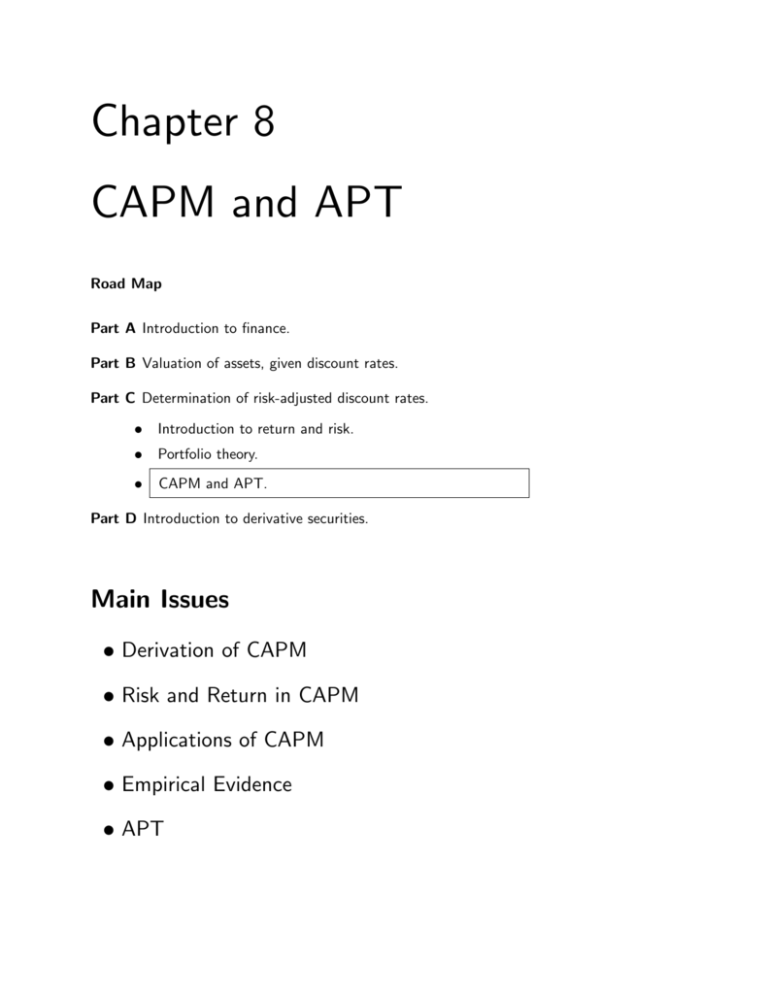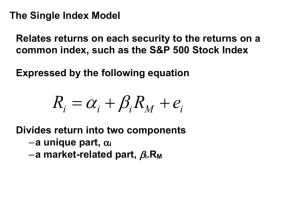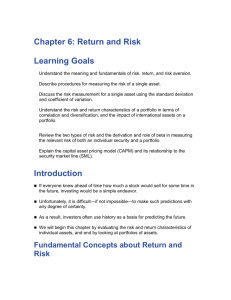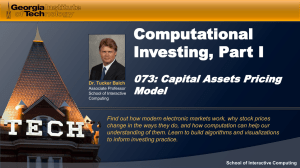Chapter 8 CAPM and APT
advertisement

Chapter 8 CAPM and APT Road Map Part A Introduction to finance. Part B Valuation of assets, given discount rates. Part C Determination of risk-adjusted discount rates. • Introduction to return and risk. • Portfolio theory. • CAPM and APT. Part D Introduction to derivative securities. Main Issues • Derivation of CAPM • Risk and Return in CAPM • Applications of CAPM • Empirical Evidence • APT Chapter 8 1 CAPM and APT 8-1 Introduction Portfolio theory analyzes investors’ asset demand given asset returns. 1. Diversify to eliminate non-systematic risk. 2. Hold only the risk-free asset and the tangent portfolio. This chapter studies how investors’ asset demand determines the relation between assets’ risk and return in a market equilibrium. A model to price risky assets. E [r̃i] = ? Fall 2006 c J. Wang 15.401 Lecture Notes 8-2 2 CAPM and APT Chapter 8 The Market Portfolio Definition: The market portfolio is the portfolio of all risky assets traded in the market. The market capitalization of an asset is its total market value. Suppose there are a total of i = 1, . . . , n risky assets. Asset i’s market capitalization is MCAPi = (price per share)i × (# of shares outstanding)i. The total market capitalization of all risky assets is MCAPM = n MCAPi. i=1 The market portfolio is the portfolio with weights in each risky asset i being MCAPi MCAPi wi = n = . MCAP MCAP j M j=1 We denote the market portfolio by wM. 15.401 Lecture Notes c J. Wang Fall 2006 Chapter 8 3 CAPM and APT 8-3 Derivation of CAPM Assumptions for this chapter: 1. Investors agree on the distribution of asset returns. 2. Investors hold efficient frontier portfolios. 3. There is a risk-free asset: • paying interest rate rF • in zero net supply. 4. Demand of assets equals supply in equilibrium. Implications: 1. Every investor puts their money into two pots: • the riskless asset • a single portfolio of risky assets – the tangent portfolio. 2. All investors hold the risky assets in same proportions • they hold the same risky portfolio, the tangent portfolio. 3. The tangent portfolio is the market portfolio. Fall 2006 c J. Wang 15.401 Lecture Notes 8-4 CAPM and APT Chapter 8 CAPM requires that in equilibrium total asset holdings of all investors must equal the total supply of assets. We show this through the example below. There are only three risky assets, A, B and C. Suppose that the tangent portfolio is wT = (wA , wB , wC ) = (0.25, 0.50, 0.25). There are only three investors in the economy, 1, 2 and 3, with total wealth of 500, 1000, 1500 billion dollars, respectively. Their asset holdings (in billion dollars) are: Investor 1 2 3 Total Riskless 100 200 -300 0 A 100 200 450 750 B C 200 100 400 200 900 450 1500 750 Claim: The market portfolio is the tangent portfolio: wM = wT . 15.401 Lecture Notes c J. Wang Fall 2006 Chapter 8 CAPM and APT 8-5 In equilibrium, the total dollar holding of each asset must equal its market value: Market capitalization of A = $750 billion Market capitalization of B = $1500 billion Market capitalization of C = $750 billion. The total market capitalization is 750 + 1500 + 750 = $3, 000 billion. The market portfolio is the tangent portfolio: 750 1500 750 , , 3000 3000 3000 wM = = (0.25, 0.50, 0.25) = wT . 5.00 4.50 Efficiency frontier 4.00 Return (%, per month) 3.50 3.00 T=M 2.50 2.00 1.50 1.00 0.50 0.00 0.0 1.0 2.0 3.0 4.0 5.0 6.0 7.0 8.0 9.0 10.0 Standard Deviation (%, per month) Fall 2006 c J. Wang 15.401 Lecture Notes 8-6 CAPM and APT 4 Chapter 8 The CAPM 4.1 Contribution of An Asset to A Portfolio In the presence of a risk-free asset, a portfolio’s return is n n n r̃p = 1 − wi r F + wi r̃i = rF + wi (r̃i −rF) . i=1 i=1 i=1 Expected return. The expected portfolio return is r̄p = rF + n wi (r̄i −rF) . i=1 The marginal contribution of risky asset i to the expected portfolio return is its risk premium: Δr̄p = r̄i − rF. Δwi (“Marginal contribution of x to A” means the incremental changes of A when x changes by a small amount.) 15.401 Lecture Notes c J. Wang Fall 2006 Chapter 8 CAPM and APT 8-7 Risk. The variance of portfolio return is the sum of all entries of the table: w1 r1 w2 r2 2σ2 w1 1 w1 r1 ··· w n rn w1 w2 σ12 · · · w1 wn σ1n 2σ2 w2 2 w2 r2 w2 w1 σ21 .. ··· . .. . · · · w2 wn σ2n .. ... . wn rn wn w1 σn1 wn w2 σn2 · · · 2σ2 wn n The sum of the entries of the i-th-row and the i-th column is the total contribution of asset i to portfolio variance: wi2 σi2 + 2 n wi wj σij . j=i The marginal contribution of asset i to portfolio variance is: Δσp2 Δwi = 2wi σi2 +2 n wj σij = 2 n wj σij j=1 j=i = 2 Cov[r̃i, r̃p]. The marginal contribution of asset i to portfolio volatility is Δσp 1 Δσp2 = = Cov[r̃i , r̃p]/σp = σip/σp. Δwi 2σp Δwi Fall 2006 c J. Wang 15.401 Lecture Notes 8-8 CAPM and APT 4.2 Chapter 8 Individual Asset and the Market Portfolio Definition: The (marginal) return-to-risk ratio (RRR) of risky asset i in a portfolio p is: RRRi = r̄i − rF (Δr̄p/Δwi ) marginal return = . = marginal risk (Δσp /Δwi) (σip/σp ) Claim: For the market (tangent) portfolio, the return-to-risk ratio of all risky assets must be the same: RRRi = r̄i − rF r̄M − rF = RRRT = . (σiM/σM ) σM Intuition: The RRR of a frontier portfolio cannot be improved. 5.00 4.50 Efficiency frontier 4.00 Return (%, per month) 3.50 3.00 T 2.50 2.00 1.50 1.00 0.50 0.00 0.0 1.0 2.0 3.0 4.0 5.0 6.0 7.0 8.0 9.0 10.0 Standard Deviation (%, per month) 15.401 Lecture Notes c J. Wang Fall 2006 Chapter 8 CAPM and APT 8-9 Re-writing r̄M − rF r̄i − rF = (σiM/σM) σM we have the following important result: r̄i − rF = σiM (r̄M − rF) = βiM (r̄M − rF) 2 σM where 2 βiM = σiM/σM is the beta of asset i with respect to the market portfolio. This is the CAPM: • βiM gives a measure of asset i’s systematic risk • r̄M − rF gives the premium per unit of systematic risk • The risk premium on asset i equals the amount of its systematic risk times the premium per unit of the risk. Fall 2006 c J. Wang 15.401 Lecture Notes 8-10 CAPM and APT Chapter 8 The relation between an asset’s premium and its market beta is called the “Security Market Line” (SML). Security Market Line (SML) r̄ SML 6 r̄ r̄ r v M ` ` s i ` ` ` ` ` ` ` ` ` ` ` ` ` ` ` ` ` M ` ` ` ` ` F ` ` ` ` ` M ⎫ ⎪ ⎪ ⎬ ⎪ ⎪ ⎭ βi r̄ − rF βM = 1 - β Given an asset’s beta, we can determine its expected return. 15.401 Lecture Notes c J. Wang Fall 2006 Chapter 8 CAPM and APT 8-11 Example. Suppose that CAPM holds. The expected market return is 14% and T-bill rate is 5%. 1. What should be the expected return on a stock with β = 0? Answer: Same as the risk-free rate, 5%. Note: • The stock may have significant uncertainty in its return. • This uncertainty is uncorrelated with the market return. 2. What should be the expected return on a stock with β = 1? Answer: The same as the market return, 14%. 3. What should be the expected return on a portfolio made up of 50% T-bills and 50% market portfolio? Answer: the expected return should be r̄ = (0.5)(0.05) + (0.5)(0.14) = 9.5%. 4. What should be expected return on stock with β = −0.6? Answer: The expected return should be r̄ = 0.05 + (−0.6)(0.14 − 0.05) = −0.4%. How can this be? Fall 2006 c J. Wang 15.401 Lecture Notes 8-12 5 CAPM and APT Chapter 8 Understanding Risk/Return in CAPM We can decompose an asset’s return into three pieces: r̃i − rF = αi + βiM (r̃M − rF) + ε̃i where • E[ε̃i] = 0 • Cov[r̃M, ε̃i] = 0. Three characteristics of an asset: • Beta. • Sigma = StD (ε̃i). • Alpha. 15.401 Lecture Notes c J. Wang Fall 2006 Chapter 8 CAPM and APT 8-13 Beta r̃i − rF = αi + βiM (r̃M − rF) + ε̃i • Beta measures an asset’s systematic risk. • Assets with higher betas are more sensitive to the market. Two assets with same total volatility but different betas 2 2 1.5 1.5 1 1 0.5 0.5 0 0 −0.5 −0.5 10 20 time 30 40 10 2 2 1.5 1.5 asset return asset return asset beta = 1.2 return return asset beta = 0.2 1 0.5 40 0.5 0 −0.5 −0.5 0.6 0.8 1 market return 30 1 0 0.4 20 time 1.2 0.4 0.6 0.8 1 market return 1.2 (Market premium = 8%, market volatility = 25%, asset volatility = 40%.) Solid lines – asset returns. Dotted lines – market returns. Fall 2006 c J. Wang 15.401 Lecture Notes 8-14 CAPM and APT Chapter 8 Sigma r̃i − rF = αi + βiM (r̃M − rF) + ε̃i • An asset’s sigma measures its non-systematic risk. • Non-systematic risk is uncorrelated with systematic risk. Two assets with same total volatility but different betas 1.5 1.5 1 1 0.5 0.5 0 0 −0.5 −0.5 10 20 time 30 40 1.5 1.5 1 1 return return asset beta = 1.2 return return asset beta = 0.2 0.5 0 −0.5 −0.5 20 time 30 20 time 30 40 10 20 time 30 40 0.5 0 10 10 40 (Market premium = 8%, market volatility = 25%, asset volatility = 40%.) Solid lines – asset returns. Dotted lines – market returns. Dashdot lines – market component. Dashed lines – idiosyncratic component. 15.401 Lecture Notes c J. Wang Fall 2006 Chapter 8 CAPM and APT 8-15 We can decompose return and risk as follows: systematic component r̃i − rF = Var[r̃i] βiM (r̃M − rF) systematic risk total risk = non-systematic component 2 βiM Var[r̃M] ε̃i + . non-systematic risk + Var[ε̃i] . Example. Systematic risk is only a part of return volatility. Consider an asset with • annual volatility (σ ) of 40% • market beta of 1.2. Suppose that the annual volatility of the market is 25%. What percentage of the total variance of the asset is attributable to non-systematic risk? (0.4)2 = (1.2)2 (0.25)2 + Var[ε̃]. Var[ε̃] = 0.0700. σε = 0.2646. Non-systematic risk 0.07 = = 43.75%. Total risk 0.16 Fall 2006 c J. Wang 15.401 Lecture Notes 8-16 CAPM and APT Chapter 8 Example. Two assets with the same total risk can have very different systematic risks. Suppose that σM = 20%. Stock 1 2 Business Market beta Residual variance Steel 1.5 0.10 Software 0.5 0.18 What is the total variance of each return? 2 = β 2 σ2 + σ2 σ1 1ε 1M M = (1.5)2 (0.2)2 + 0.10 = 0.19 2 = β 2 σ2 + σ2 σ2 2ε 2M M = (0.5)2 (0.2)2 + 0.18 = 0.19. However (1.5)2 (0.2)2 2 R1 = = 47% 0.19 (0.5)2 (0.2)2 2 R2 = = 5%. 0.19 15.401 Lecture Notes c J. Wang Fall 2006 Chapter 8 CAPM and APT 8-17 Alpha r̃i − rF = αi + βiM (r̃M − rF) + ε̃i • According to CAPM, α should be zero for all assets. • α measures an asset’s return in excess of its risk-adjusted award according to CAPM. What to do with an asset with a positive α? • Check estimation error. • Past value of α may not predict its future value. • Positive α may be compensating for other risks. • ... Fall 2006 c J. Wang 15.401 Lecture Notes 8-18 6 CAPM and APT Chapter 8 Applications of CAPM Example. Required rates of return on IBM and Dell. 1. Use the value-weighted stock portfolio as a proxy for the market portfolio. 2. Regress historic returns of IBM and Dell on the returns on the value-weighted portfolio. Suppose the beta estimates are βIBM,VW = 0.73 and βDell,VW = 1.63. 3. Use historic excess returns on the value weighted portfolio to estimated average market premium: π = r̄VW − rF = 8.6%. 4. Obtain the current riskless rate. Suppose it is rF = 4%. 5. Applying CAPM: r̄IBM = rF + βIBM,VW (r̄VW − rF ) = 0.04 + (0.73)(0.086) = 0.1028. The expected rate of return on IBM (under CAPM) is 10.28%. Similarly, the expected rate of return on Dell is 18.02%. 15.401 Lecture Notes c J. Wang Fall 2006 Chapter 8 CAPM and APT 8-19 Reading the Beta Book MLPF&S’s Beta Book Ticker Symbol AALA AOL GNLK GM TSN 00/03 Close Price Beta Alpha AmerAlia 2.250 -2.25 America Online 67.438 2.40 GeneLink 0.290 -7.74 General Mtrs 82.813 1.01 Tyson Foods 11.125 1.13 10.05 4.12 16.15 -0.57 -2.31 Resid –Std. Err.– Std of of R-Sqr. Dev-N. Beta Alpha 0.03 0.25 0.44 0.27 0.23 42.72 17.17 37.30 6.98 8.55 1.30 0.52 2.10 0.21 0.26 Adj. Beta Num. of Obs. 6.06 -1.15 2.44 1.93 9.92 -4.79 0.99 1.01 1.21 1.09 60 60 17 60 60 Note (a) S&P 500 is used as a proxy for the market. (b) Betas are estimated with raw returns, not risk risk premiums. The alpha, according to CAPM, is rF (1 − β). (c) Adjusted beta is obtained using other information. Fall 2006 c J. Wang 15.401 Lecture Notes 8-20 7 CAPM and APT Chapter 8 Empirical Evaluation of CAPM 1. Long-run average returns are significantly related to beta: (Source: Fisher Black, “Beta and return.”) The dots show the actual average risk premiums from portfolios with different betas. • high beta portfolios generated higher average returns • high beta portfolios fall below SML • low beta portfolios land above SML • a line fitted to the 10 portfolios would be flatter than SML. 15.401 Lecture Notes c J. Wang Fall 2006 Chapter 8 CAPM and APT 8-21 2. CAPM does not seem to work well over the last 30 years: Source: Fischer Black, “Beta and return.” The dots show the actual average risk premiums from portfolios with different betas over different periods. The relation between beta and actual average return has been much weaker since the mid-1960s. Fall 2006 c J. Wang 15.401 Lecture Notes 8-22 CAPM and APT Chapter 8 3. Factors other than beta seem important in pricing assets: Source: G. Fama and K. French, “The Cross-Section of Expected Stock Returns”. Since mid-1960s: • Small stocks have outperformed large stocks • Stocks with low ratios of market-to-book value have outperformed stocks with high ratios. 15.401 Lecture Notes c J. Wang Fall 2006 Chapter 8 8 CAPM and APT 8-23 Summary of CAPM CAPM determines risk-return trade-off: • Invest only in the risk-free asset and the market portfolio. • Beta measures systematic risk. • Required rate of return is proportional to beta. CAPM is simple and sensible: • It is built on modern portfolio theory. • It distinguishes systematic risk and non-systematic risk. • It provides a simple pricing model. CAPM is controversial: • It is difficult to test (to identify the market portfolio). • Empirical evidence is mixed. • Alternative pricing models might do better. – Multiple risks. Fall 2006 c J. Wang 15.401 Lecture Notes 8-24 9 CAPM and APT Chapter 8 Arbitrage Pricing Theory (APT) We can extend the market-risk model to include multiple risks: r̃i − rF = αi + biM (r̃M − rF) + · · · + biN (r̃N − rF) + ε̃i where • r̃M and r̃N represent common risk factors • biM and biN define asset i’s exposure to risk factors • ε̃i is part of asset i’s risk unrelated to risk factors. The Arbitrage Pricing Theory states that: r̄i − rF = biM(r̄M −rF) + · · · + biN(r̄N −rF) where • r̄k −rF is the premium on factor k • bik is asset i’s loading of factor k (i.e., αi = 0). 15.401 Lecture Notes c J. Wang Fall 2006 Chapter 8 CAPM and APT 8-25 Example. Suppose that there are two factors represented by: (1) return on the market portfolio r̃M (2) return on Treasury bond portfolio r̃N: r̃i − rF = biM(r̃M − rF) + biN(r̃N − rF) + ε̃i . Suppose that rF 5% r̄M −rF 8% r̄N −rF 2% APT implies that an asset’s risk premium is given by r̄i − rF = biM (8%) + biN (2%). Suppose for assets A, B and C, we have Asset A B C bM 1.0 1.5 1.0 bN 1.0 0.2 0.6 Then, APT implies that individual assets have to offer returns consistent with their factor exposures and factor premiums. r̄A = 0.05 + (1.0)(0.08) + (1.0)(0.02) = 15.0% r̄B = 0.05 + (1.5)(0.08) + (0.2)(0.02) = 17.4% r̄C = 0.05 + (1.0)(0.08) + (0.6)(0.02) = 14.2%. Fall 2006 c J. Wang 15.401 Lecture Notes 8-26 CAPM and APT Chapter 8 Suppose that r̄A was instead 10% (and it has only factor risks). We would then have an arbitrage: (a) buy $100 of market portfolio (b) buy $100 of bond portfolio (c) sell $100 of asset A (d) sell $100 of risk-free asset. This portfolio has the following characteristics: • requires zero initial investment (an arbitrage portfolio) • bears no factor risk (and no idiosyncratic risk) • pays (13 + 3 − 10 − 5) = $1 surely. Thus, in absence of arbitrage, APT holds. 15.401 Lecture Notes c J. Wang Fall 2006 Chapter 8 10 CAPM and APT 8-27 Implementation of APT The implementation of APT involves three steps: 1. Identify the factors 2. Estimate factor loadings of assets 3. Estimate factor premia. Strength and Weaknesses of APT 1. The model gives a reasonable description of return and risk. 2. Model itself does not say what the right factors are. Differences between APT and CAPM • APT is based on the factor model of returns and “arbitrage.” • CAPM is based on investors’ portfolio demand and equilibrium. Fall 2006 c J. Wang 15.401 Lecture Notes 8-28 11 CAPM and APT Chapter 8 Homework Readings: • BKM Chapters 9. • BMA Chapters 8, 9.1, 9.3. Assignment: • Problem Set 5. 15.401 Lecture Notes c J. Wang Fall 2006








